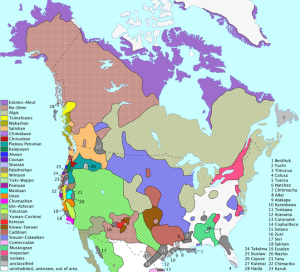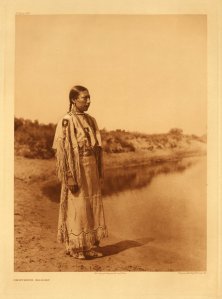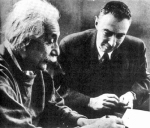
Welcome back to our discussion of Friedman, Leeson, and Skarbek’s Legal Systems Very Different from Ours. Today we’ll be looking at the legal systems of three plains Indian tribes: the Comanche, Kiowa, and Cheyenne.
(Take note of the map. We’re going to need it.)
I had previously been under the impression that these groups had started as farmers who adopted the horse when the Spanish arrived. This is the account given by the authors:
Faced with a sudden opportunity for progress, the chance to stop scratching in the dirt as primitive agriculturalists and turn into noble savages hunting buffalo… the Indian tribes living on or near the Great Plains seized the opportunity.
So the Comanche hail from the Uto-Aztecan language group–these folks included, as you can tell from the name, both the Aztecs of Mexico and the Utes of the Great Basin. (Utah is named for the Utes.) The Comanche themselves appear to have hailed from the Great Basin, an arid region that’s mostly too dry for agriculture. As Wikipedia notes:
Different ethnic groups of Great Basin tribes share certain common cultural elements that distinguish them from surrounding groups. All but the Washoe traditionally speak Numic languages, and tribal groups, who historically lived peacefully and often shared common territories, have intermingled considerably. Prior to the 20th century, Great Basin peoples were predominantly hunters and gatherers.
“Desert Archaic” or more simply “The Desert Culture” refers to the culture of the Great Basin tribes. This culture is characterized by the need for mobility to take advantage of seasonally available food supplies. The use of pottery was rare due to its weight, but intricate baskets were woven for containing water, cooking food, winnowing grass seeds and storage—including the storage of pine nuts, a Paiute-Shoshone staple. Heavy items such as metates would be cached rather than carried from foraging area to foraging area. Agriculture was not practiced within the Great Basin itself, although it was practiced in adjacent areas (modern agriculture in the Great Basin requires either large mountain reservoirs or deep artesian wells). Likewise, the Great Basin tribes had no permanent settlements, although winter villages might be revisited winter after winter by the same group of families. In the summer, the largest group was usually the nuclear family due to the low density of food supplies.
In between the Great Basin and the Aztec empire lie the Pueblos, built by the various Pueblo peoples. Interestingly, most of them do not speak an Uto-Aztecan language; some of the Pueblo languages are quite isolated. The Navajo language, likewise, is related to languages spoken way up in Canada, rather than other local languages.
The history of this region of the country post-1492 follows the Spanish, not English colonists. The Spanish conquered the Aztecs, as is rather famously known, then moved north into the Pueblos of Arizona and New Mexico in the 1540s. The Pueblos were the biggest settlements in the southwestern US in those days–California was inhabited primarily by hunter-gatherers and didn’t attract much settlement until the Spaniards developed better routes across the Pacific ocean (the need for which partially drove the Opening of Japan in the late 1800s), the Great Basin of Utah and nearby states was too dry for many permanent settlements before irrigation and wells were dug, and without horses, the Great Plains were nearly uninhabited. The first Spaniards who crossed them found them horrifyingly vast and empty.
On the other side of the Great Plains lay the Mississippian people, who, like the Puebloans, built towns and cities, as well as monuments like Serpent Mound in Ohio–but these folks were beyond the normal reach of the Spanish empire. To the far north were other peoples, like the totem-pole carving denizens of the lush Pacific northwest but this was Russian territory at most, and generally left to its own devices.
In those days, the peoples of the Great Basin were mostly nomadic hunter gatherers, occasionally trading with farmers and pastoralists from the south and moving with the seasons. Their only “draft animal” was the dog, which pulled sleds (travois) laden with their belongings over the ground; this is not a terribly effective way to move.

The Pueblos revolted against Spanish rule in 1680. The revolt was successful, and about 2,000 Spaniards and their slaves were driven from the territory and their domesticated animals–including horses–were variously slaughtered, captured, or lost to the wilds. The horses took easily to what had formerly been their native habitat, and by the mid-1700s, the Comanches had them.
Gone were the days of puttering around with puny, dog-drawn sleds; for the next hundred years these fearsome warriors were the lords of the southern plains, the quintessential horseback riding, tipi-dwelling, buffalo hunting anarchists of American lore.
According to Wikipedia:
Their original migration took them to the southern Great Plains, into a sweep of territory extending from the Arkansas River to central Texas. The earliest references to them in the Spanish records date from 1706, when reports reached Santa Fe that Utes and Comanches were about to attack [16]. In the Comanche advance, the Apaches were driven off the Plains. By the end of the eighteenth century the struggle between Comanches and Apaches had assumed legendary proportions: in 1784, in recounting the history of the southern Plains, Texas governor Domingo Cabello recorded that some sixty years earlier (i.e., ca. 1724) the Apaches had been routed from the southern Plains in a nine-day battle at El Gran Cierra del Fierro ‘The Great Mountain of Iron’, somewhere northwest of Texas. There is, however, no other record, documentary or legendary, of such a fight [17].
They were formidable opponents who developed strategies for using traditional weapons for fighting on horseback. Warfare was a major part of Comanche life. Comanche raids into Mexico traditionally took place during the full moon, when the Comanche could see to ride at night. This led to the term “Comanche Moon”, during which the Comanche raided for horses, captives, and weapons.[18] The majority of Comanche raids into Mexico were in the state of Chihuahua and neighboring northern states.[19]

The Comanche were such effective warriors that they nearly turned the tide against Spanish colonization:
The Comanche–Mexico Wars was the Mexican theater of the Comanche Wars, a series of conflicts from 1821 until 1870 which consisted of large-scale raids into northern Mexico by Comanches and their Kiowa and Kiowa Apache allies which left thousands of people dead.[1] The Comanche raids were sparked by the declining military capability of Mexico in the turbulent years after it gained independence in 1821, plus a large and growing market in the United States for stolen Mexican horses and cattle.[2]
By the time the United States army invaded northern Mexico in 1846 during the Mexican–American War the region was devastated. The largest Comanche raids into Mexico took place from 1840 until the mid-1850s, thereafter declining in size and intensity. The Comanche were finally defeated by the U.S. in 1875 and forced onto a reservation.
(Their defeat was due in large part due to the decimating effects of disease; their population appears to have dropped from about 20,000 people to just a few thousand. Today, they number about 17,000 people.
So that’s where the Comanche came from. How about the Kiowa?

The Kiowa speak a Tanoan language, not an Uto-Aztecan language like the Comanche. Most of the other Tanoan speakers are Pueblo peoples, who built permanent towns and raised corn in New Mexico, but the Kiowa were hunter gatherers from around the Black Hills of western Montana/South Dakota. They were driven from their homelands by the Sioux and other tribes, migrated south, obtained horses, and moved into the flat parts of Colorado, Kansas, Oklahoma, northern Texas, and parts of New Mexico. According to Wikipedia, they numbered about 3,000 people in those days and 12,000 today.
This leaves us with a mystery: the historic geographic spread of the Uto-Axtecan language family was split by the Pueblos; the historic geographic spread of the Pueblo-based Tanoan family was split by the Great Basin-dwelling Utes and their linguistic cousins. In other words, each language family was split by the other.
How did the Kiowa begin their journey so far from the other members of their language family? Wikipedia frustratingly notes:
There is apparently no oral tradition of any ancient connection between the peoples. Scholars have not determined when the peoples were connected so that the common linguistic elements could have developed.
Archaeology offers many tantalizing clues, but I wish we had more genetic data (many American Indian tribes are officially disdainful of genetics and see nothing to be gained by participating in genetics research, which may be true for them but is frustrating to me.)
The Wikipedia page for the Kiowa language says:
Although Kiowa is most closely related to the other Tanoan languages of the Pueblos, the earliest historic location of its speakers is western Montana around 1700. Prior to the historic record, oral histories, archaeology, and linguistics suggest that pre-Kiowa was the northernmost dialect of Proto-Kiowa-Tanoan, spoken at Basketmaker II Era sites. Around AD 450, they migrated northward through the territory of the Anasazi and Great Basin, occupying the eastern Fremont culture region of the Colorado Plateau until sometime before 1300. Speakers then drifted northward to the northwestern Plains, arriving no later than the mid-16th century in the Yellowstone area where the Kiowa were first encountered. The Kiowa then later migrated to the Black Hills and the southern Plains, where the language was recorded in historic times.[3]
(Basketmaker II is from roughly 50-500 AD.)
The full history is likely to be complicated. Corn was domesticated in southern Mexico around 9,000 years ago and soon spread to both South America and the Mississippian cultures of the eastern US. The ancestors of the early Pueblo peoples adopted it, but the Aztecs were still hunter-gatherers when they conquered the Valley of Mexico around 1250 AD. Perhaps the same pressures that sent the Aztecs into the Valley of Mexico also drove the Kiowa north–or perhaps the events were entirely unrelated, separated by hundreds of years. History is frustratingly silent.
The introduction of the horse to Kiowa society revolutionized their [hunter-gatherer] way of life. They acquired horses by raiding rancheros south of the Rio Grande into Mexico, as well as by raiding other Indian peoples who already had horses, such as the Navajo and the various Pueblo people. With the horse, they could transport larger loads, hunt more game over a wider range and more easily, and travel longer and farther. The Kiowa became powerful and skilled mounted warriors who conducted long-distance raids against enemies. The Kiowa were considered among the finest horsemen on the Plains. A man’s wealth was measured primarily by the size of his horse herd, with particularly wealthy individuals having herds numbering in the hundreds. … The Kiowa considered it an honor to steal horses from enemies, and such raids often served as a rite of passage for young warriors. …
In the early spring of 1790 at the place that would become Las Vegas, New Mexico, a Kiowa party led by war leader Guikate, made an offer of peace to a Comanche party while both were visiting the home of a mutual friend of both tribes. … The two groups made an alliance to share the same hunting grounds and entered into a mutual defense pact and became the dominant inhabitants of the Southern Plains. … In addition to the Comanche, the Kiowa formed a very close alliance with the Plains Apache (Kiowa-Apache), with the two nations sharing much of the same culture and participating in each other’s annual council meetings and events.
Note: the Plains Apache do not speak a language related to Kiowa or Comanche–their language is from the Athabaskan family, which is spoken primarily in Canada and by the Navajo. The Plains Apache were apparently never very numerous–only about 400 people at the time.
The strong alliance of southern plains nations kept the invading Spanish from gaining a strong colonial hold on the southern plains and eventually forced them completely out of the area, pushing them eastward and south past the Rio Grande into present day Mexico. …
The Kiowa were notable even among plains Indians for their long-distance raids, including raids far south into Mexico and north onto the northern plains. Almost all warfare took place while mounted on horses.
These “raids” involved not just stealing horses, but also raping, torturing, and murdering people. The fact that the area was full of extremely hostile Indians who liked to torture people for fun was why the Mexican government thought it was a good idea to let a bunch of Americans come settle in their Texas territory and deal with the Indians for them.
The Kiowa kept plenty busy:
Enemies of the Kiowa include the Cheyenne, Arapaho, Navajo, Ute, and occasionally Lakota to the north and west of Kiowa territory. East of Kiowa territory they fought with the Pawnee, Osage, Kickapoo, Kaw, Caddo, Wichita, and Sac and Fox. To the south they fought with the Lipan Apache, Mescalero Apache, and Tonkawa. The Kiowa also came into conflict with Indian nations from the American south and east displaced to Indian Territory during the Indian Removal period including the Cherokee, Choctaw, Muskogee, and Chickasaw. Eastern tribes found that Indian Territory, the place they were sent, was already occupied by plains Indians, most notably the Kiowa and Comanche.

The Cheyenne speak a tongue from yet another language family, the Algonquian (which is part of the broader Algic family), found across most of eastern Canada and the north eastern American coast along the Atlantic. The famous Squanto of the Wampanoag spoke an Algonquin language.
The history of the Cheyenne is thankfully better documented:
The earliest known written historical record of the Cheyenne comes from the mid-17th century, when a group of Cheyenne visited the French Fort Crevecoeur, near present-day Peoria, Illinois. The Cheyenne at this time lived between the Mississippi River and Mille Lacs Lake in present-day Minnesota. The Cheyenne economy was based on the collection of wild rice and hunting, especially of bison, which lived in the prairies 70–80 miles west of the Cheyenne villages.[11]
According to tribal history, during the 17th century, the Cheyenne had been driven by the Assiniboine … from the Great Lakes region to present-day Minnesota and North Dakota, where they established villages. The most prominent of the ancient Cheyenne villages is Biesterfeldt Village, in eastern North Dakota along the Sheyenne River. The tribal history also relates that they first reached the Missouri River in 1676.[12] A more recent analysis of early records posits that at least some of the Cheyenne remained in the Mille Lac region of Minnesota until about 1765, when the Ojibwe defeated the Dakota with firearms — pushing the Cheyenne, in turn, to the Minnesota River, where they were reported in 1766.[13] …
By 1776, the Lakota had overwhelmed the Cheyenne and taken over much of their territory near the Black Hills. In 1804, Lewis and Clark visited a surviving Cheyenne village in North Dakota.
According to what I believe is oral history recorded in Wikipedia, a Cheyenne prophet named Tomȯsévėséhe (“Erect Horns”) received a vision which convinced the tribe to abandon their agricultural was and become plains nomads.
The Cheyenne occupied the plains north of the Comanche and Kiowa, though they sometimes came south. Their lifestyle was similar to the others’ and they fought with/raided from pretty much everyone around, though they eventually allied with their neighbors against the US.
Okay, guys, I’ve been working on this for hours and I haven’t even gotten to the actual legal systems yet, so we’re going to have to call it quits until I get some more time. (To be fair, the authors covered three different groups in this chapter, which makes for triple the background work.) For now, a quick summary:
The Comanche, Kiowa, and Cheyenne (and Plains Apache) hail from four different language families. It is rare in the modern world to find so many different language families in such close proximity to each other.
Native American history is complex, with many population movements that are not well understood or documented.
The Comanche are descended from primarily hunter-gatherers, the Kiowa were related to agricultural peoples and might have done agriculture at some point in their past, and the Cheyenne were directly descended from agriculturalists who purposefully decided to adopt a nomadic lifestyle.
These differences in their origins might account for some of the differences in governance of their societies, despite the similarities they developed due to leading similar lifestyles dependent on hunting buffalo and stealing horses.
See you next week.
 Welcome back to Leeson, Skarbek, and Friedman’s
Welcome back to Leeson, Skarbek, and Friedman’s 


 The inverse of loving what is yours is that you do not love what is not yours.
The inverse of loving what is yours is that you do not love what is not yours.







 Sapiens’ technology didn’t do much interesting for the first couple hundred thousand years, either. Yet 70,000 years ago, sapiens did manage to leave Africa, displace the Neanderthals, spread into radically new climates, developed long distance trade and art, and eventually agriculture and everything we now enjoy here in the modern world.
Sapiens’ technology didn’t do much interesting for the first couple hundred thousand years, either. Yet 70,000 years ago, sapiens did manage to leave Africa, displace the Neanderthals, spread into radically new climates, developed long distance trade and art, and eventually agriculture and everything we now enjoy here in the modern world. If a specific event triggered the simultaneous development of figurative art–and other aspects of behavioral modernity–in four different parts of the world, that event would logically have occurred before those groups split up. The timing of our
If a specific event triggered the simultaneous development of figurative art–and other aspects of behavioral modernity–in four different parts of the world, that event would logically have occurred before those groups split up. The timing of our